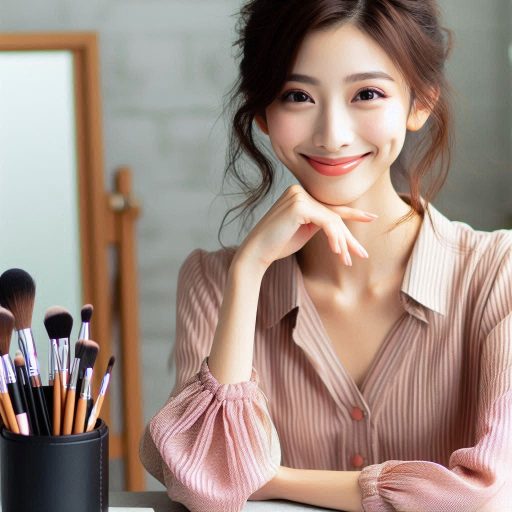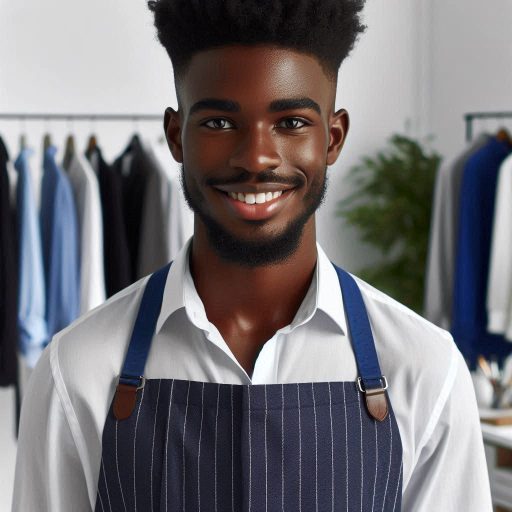Introduction
A professional fashion stylist curates and enhances personal and editorial styles.
They blend clothing, accessories, and aesthetics to create cohesive looks.
Fashion stylists work with individuals, brands, and magazines, ensuring their appearance aligns with current trends or personal preferences.
They play a crucial role in shaping the fashion industry, influencing public perceptions of style.
Fashion stylists help clients express their personalities and maintain a polished appearance.
They provide expert advice on wardrobe choices, ensuring outfits suit occasions and body types.
Their work extends to organizing photoshoots, managing fashion shows, and collaborating with designers.
They ensure that every detail complements the overall vision.
In this blog post, we’ll explore a typical day for a fashion stylist.
We’ll discuss daily tasks, including client consultations, wardrobe selection, and on-set styling.
We’ll also delve into the skills required to succeed in this dynamic profession.
Finally, we’ll highlight the challenges and rewards of working as a fashion stylist.
Fashion stylists not only impact how we dress but also influence trends and brand identities.
Understanding their daily responsibilities offers insight into the creativity and dedication behind the glamorous world of fashion.
Morning Routine
Waking up early
A professional fashion stylist’s day starts early.
Rising before dawn is essential to stay ahead of a busy schedule.
Mornings are dedicated to setting the tone for the day.
Checking emails and schedules
The first task is checking emails.
Stylist’s inboxes are often filled with client requests, appointment confirmations, and vendor updates.
Responding promptly ensures smooth operations throughout the day.
Transform Your Career Today
Unlock a personalized career strategy that drives real results. Get tailored advice and a roadmap designed just for you.
Start NowNext, they review their schedule. They need to know the details of appointments, fittings, and meetings.
This helps in planning the day’s work efficiently.
Each meeting might require specific outfits or preparation.
Planning outfits for the day’s appointments
Planning outfits is crucial. The stylist carefully selects ensembles that align with each client’s needs and preferences.
They consider trends, client requests, and upcoming events.
Outfits are often laid out and organized for easy access.
Preparing for a fitting involves more than just choosing clothes.
The stylist must also consider accessories and shoes.
Every detail is meticulously planned to ensure a polished presentation.
The morning routine is about more than just tasks.
It sets the stage for a productive and successful day.
well-organized start leads to a seamless flow of appointments and client interactions.
In essence, the morning routine of a fashion stylist combines early rising, email management, and meticulous planning.
These steps are crucial for a successful day of styling and client service.
Read: How to Build a Strong Portfolio as a Fashion Stylist
Client Meetings
Client meetings are an essential part of a professional fashion stylist’s job.
These meetings provide an opportunity to engage with clients, understand their fashion needs, and offer valuable advice and suggestions for their wardrobe choices.
Meeting with clients to discuss their fashion needs
During the initial client meeting, the fashion stylist sits down with the client to discuss their fashion needs.
This conversation is crucial as it helps the stylist understand the client’s lifestyle, preferences, and budget.
The stylist will ask questions to determine the client’s specific requirements, such as whether they need outfits for work, special events, or everyday wear.
Transform Your Career Today
Unlock a personalized career strategy that drives real results. Get tailored advice and a roadmap designed just for you.
Start NowBy gathering this information, the stylist can create a personalized styling plan tailored to the client’s needs.
Understanding their personal style preferences
Another important aspect of client meetings is understanding the client’s personal style preferences.
The stylist will inquire about the client’s favorite colors, silhouettes, patterns, and designers to get a sense of their aesthetic.
By understanding the client’s personal style, the stylist can curate a selection of garments and accessories that resonate with the client’s taste.
This ensures that the client feels comfortable and confident in the outfits chosen for them.
Offering advice and suggestions for wardrobe choices
Based on the information gathered during the client meeting, the fashion stylist offers advice and suggestions for wardrobe choices.
This may include recommending key pieces to invest in, suggesting ways to mix and match existing items, or proposing new trends to try.
The stylist’s goal is to help the client build a versatile and cohesive wardrobe that aligns with their personal style.
By providing expert guidance and creative input, the stylist empowers the client to make informed decisions about their fashion choices.
Read: Creating Avant-Garde Looks: Tips for Makeup Artists
Shopping and Styling Sessions
Going shopping for clothes, accessories, and shoes
As a professional fashion stylist, one of the most exciting parts of my job is going shopping for clothes, accessories, and shoes.
Each shopping trip is like a treasure hunt, searching for the perfect pieces to complete a client’s wardrobe.
Curating Outfits for Clients
When I meet with clients, I always take the time to understand their personal style, preferences, and lifestyle.
This information helps me curate outfits that not only look great but also make them feel confident and comfortable.
I pay attention to every detail, from the fit and color to the overall aesthetic.
Mixing and matching different pieces to create unique and cohesive looks is where my creativity shines.
I love the challenge of putting together unexpected combinations that work seamlessly together.
Whether it’s for a casual day out, a formal event, or a photoshoot, I take pride in ensuring that my clients feel like the best version of themselves in the outfits I style for them.
Styling Clients for Special Occasions
One of the most rewarding aspects of my job is styling clients for special occasions.
Whether it’s a wedding, red carpet event, or milestone celebration, I love the opportunity to create looks that leave a lasting impression.
Transform Your Career Today
Unlock a personalized career strategy that drives real results. Get tailored advice and a roadmap designed just for you.
Start NowFor these high-profile events, I work closely with designers, brands, and tailors to bring my vision to life.
From selecting the perfect gown to coordinating accessories and finalizing hair and makeup, every detail is meticulously planned to ensure my client looks and feels like a star.
Seeing my clients light up with confidence and joy when they step out in a meticulously styled ensemble is what drives me to continue pushing the boundaries of creativity and fashion.
Overall, shopping and styling sessions are the heartbeat of my profession.
They allow me to unleash my creativity, connect with clients on a personal level, and bring their fashion dreams to life.
Read: Essential Tools Every Fashion Stylist Should Own

Trend Research
As a professional fashion stylist, staying current with the latest fashion trends is crucial.
Researching upcoming trends for the season is a key aspect of the job.
Incorporating these trends into client styling helps to keep their look fresh and relevant.
Why Trend Research is Important
By staying on top of trends, you can offer clients the most up-to-date styling options.
It shows that you are knowledgeable and well-informed about the fashion industry.
Clients trust your expertise and are more likely to seek your services repeatedly.
Trend research also allows you to provide personalized styling recommendations tailored to each client’s preferences.
How to Keep Up with the Latest Fashion Trends
Follow fashion influencers and designers on social media platforms like Instagram and Twitter.
Subscribe to fashion magazines and websites to stay informed about the latest trends.
Attend fashion shows, both in-person and virtually, to see the upcoming collections firsthand.
Join fashion trend forecasting services to get exclusive insights into upcoming trends.
Incorporating Trends into Client Styling
After conducting thorough trend research, analyze which trends align with your client’s personal style.
Experiment with incorporating subtle elements of trends into their existing wardrobe for a seamless transition.
Don’t overwhelm the client with too many trends at once – focus on one or two key pieces per outfit.
Transform Your Career Today
Unlock a personalized career strategy that drives real results. Get tailored advice and a roadmap designed just for you.
Start NowOffer guidance on how to style the trend to suit their body shape and lifestyle.
Case Study: Trend Research in Action
- Client A: A young professional looking to update her work wardrobe for the upcoming season.
- Trend Research: Identified key trends for the season – oversized blazers, statement sleeves, and bold prints.
- Styling Approach: Suggested incorporating an oversized blazer in a neutral tone paired with classic tailored trousers.
- Result: Client A felt confident and fashion-forward in her updated work wardrobe, receiving compliments from colleagues.
Trend research is a fundamental aspect of a professional fashion stylist’s job.
By staying informed and incorporating trends into client styling, you can elevate their look and build trust with clients.
Remember to balance trendiness with each client’s personal style to create a unique and tailored wardrobe for them.
Read: Mastering Bridal Makeup: Tips for Artists
Photoshoots and Events
Attending photoshoots for editorial spreads or advertisements
As a professional fashion stylist, a significant portion of my job involves attending photoshoots and events.
Whether it’s for editorial spreads in magazines, advertisements, fashion shows, red carpet events, or celebrity appearances, I am always on the go, ensuring that the outfits are perfect for the occasion.
When it comes to photoshoots, my role is crucial in making sure that the clothing and accessories chosen for the shoot are not only visually appealing but also on-trend.
I work closely with photographers, models, hair and makeup artists, and other members of the creative team to bring the vision to life.
For editorial spreads, I carefully select pieces from various designers to create looks that will stand out in print.
I pay attention to every detail, from the fit of the garments to the styling of accessories, to ensure that the final images are stunning and capture the essence of the story being told.
In the world of advertisements, I collaborate with art directors and clients to understand the brand’s identity and target audience.
I then curate outfits that align with the brand’s image while also being visually appealing and memorable.
Styling for fashion shows, red carpet events, or celebrity appearances
When it comes to styling for fashion shows, red carpet events, or celebrity appearances, the pressure is on to create show-stopping looks that will turn heads and generate buzz.
I stay up-to-date on the latest trends and designers to ensure that my clients are always ahead of the curve.
Ensuring outfits are camera-ready and on-trend
Before each event, I carefully select outfits that not only complement the client’s personality and style but also make a statement.
From glamorous gowns for red carpet events to edgy, fashion-forward looks for runway shows, I make sure that every detail is perfect.
On the day of the event or photoshoot, I am responsible for dressing the client or model, making sure that every piece fits perfectly and looks flawless.
I pay attention to how the garments move on camera, ensuring that they photograph well and capture the desired aesthetic.
Overall, photoshoots and events are some of the most exciting aspects of my job as a fashion stylist.
Transform Your Career Today
Unlock a personalized career strategy that drives real results. Get tailored advice and a roadmap designed just for you.
Start NowI love the creative process of piecing together looks, collaborating with other talented professionals, and seeing the final result come to life in captivating images and memorable moments.
Networking and Collaboration
Building relationships with designers, photographers, and other industry professionals
Networking and collaboration are essential aspects of a professional fashion stylist’s career.
Building strong relationships with designers, photographers, and other industry professionals is crucial for success in the competitive fashion industry.
By networking with designers, stylists can gain access to the latest collections and trends, as well as establish a rapport that can lead to future collaborations.
Photographers play a key role in capturing the stylist’s work, so maintaining a good relationship with them is essential for creating visually appealing content.
Collaborating on projects with other stylists or fashion influencers
Collaborating on projects with other stylists or fashion influencers can also open up new opportunities and help stylists expand their creative horizons.
Working with others allows stylists to learn from different perspectives and styles, ultimately enhancing their own skills and knowledge.
Attending fashion events and industry mixers to expand professional network
Attending fashion events and industry mixers is another important aspect of networking for fashion stylists.
These events provide an opportunity to meet new people, showcase their work, and stay up-to-date on the latest industry trends.
Building a strong professional network can lead to new partnerships, job opportunities, and collaborations in the future.
Overall, networking and collaboration are essential for a professional fashion stylist to thrive in the industry.
By building relationships with key industry players and collaborating on projects with others, stylists can expand their professional network, gain new insights, and take their career to the next level.
Social Media and Marketing
As a professional fashion stylist, social media and marketing play a crucial role in expanding my client base and showcasing my work to a wider audience.
With the rise of digital platforms, it has become essential to have a strong online presence to attract potential clients and establish credibility in the industry.
Managing Social Media Accounts
One of the key aspects of my job is curating and managing social media accounts to showcase my styling work.
Platforms like Instagram and Facebook allow me to share behind-the-scenes glimpses of styling sessions, outfit inspiration, and client transformations.
By posting regularly and engaging with followers, I can build a loyal following and attract new clients who are interested in my services.
Creating Content for Website or Blog
In addition to social media, having a professional website or blog is essential for highlighting my styling services and portfolio.
I regularly update my website with my latest projects, client testimonials, and styling tips to showcase my expertise in the field.
By providing valuable content, I can attract organic traffic to my site and convert visitors into potential clients.
Transform Your Career Today
Unlock a personalized career strategy that drives real results. Get tailored advice and a roadmap designed just for you.
Start NowUtilizing Online Platforms for Marketing
Online platforms offer a variety of marketing tools that I leverage to promote my services and reach a broader audience.
From running targeted ads on social media to collaborating with influencers and fashion bloggers, I explore different strategies to boost brand visibility and attract clients.
By staying updated on digital marketing trends and analytics, I can optimize my online presence for maximum impact.
In a nutshell, social media and marketing are essential components of a professional fashion stylist’s daily routine.
By effectively managing social media accounts, creating engaging content for websites or blogs, and utilizing online platforms for marketing, I can showcase my work, attract new clients, and establish a strong presence in the fashion industry.
Embracing digital tools and strategies allows me to stay competitive and relevant in a constantly evolving field.
Conclusion
A day in the life of a professional fashion stylist is packed with creativity, hard work, and dedication.
From selecting outfits to organizing photoshoots and keeping up with fashion trends, this role requires a combination of skills and passion.
Aspiring fashion stylists should not be discouraged by the demanding nature of the job, but instead, be inspired to pursue their dreams in the industry.
With dedication and commitment, anyone with a love for fashion can succeed in this competitive yet rewarding field.
[E-Books for Sale]
The Big Book of 500 High-Paying Jobs in America: Unlock Your Earning Potential
$19.99 • 500 High-Paying Jobs • 330 pages
Explore 500 high-paying jobs in America and learn how to boost your career, earn more, and achieve success!
See All 500 High-Paying Jobs of this E-Book
1001 Professions Without a Degree: High-Paying American Jobs You Can Start Now
$19.99 • 1001 Professions Without a Degree • 174 pages
Discover 1001 high-paying jobs without a degree! Unlock career tips, skills, and success strategies for just $19.99!




